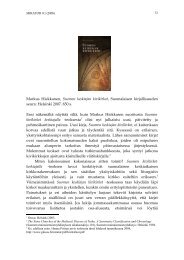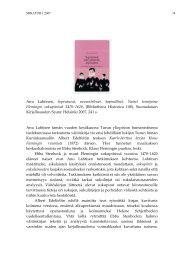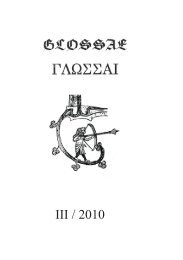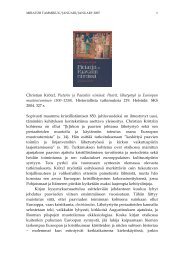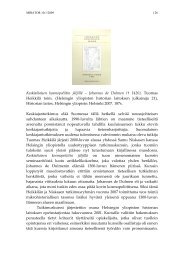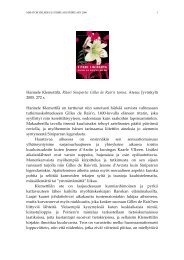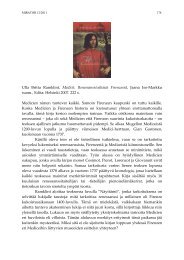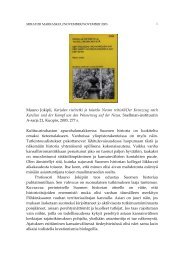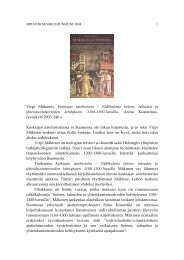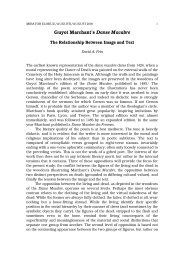Sigurðar saga fóts (The Saga of Sigurðr Foot)
Sigurðar saga fóts (The Saga of Sigurðr Foot)
Sigurðar saga fóts (The Saga of Sigurðr Foot)
Create successful ePaper yourself
Turn your PDF publications into a flip-book with our unique Google optimized e-Paper software.
MIRATOR 11:1/2010 58past work on it, and the core evidence for its literary milieu: evidence for itsdate; what other texts it influenced; and what texts it draws on.Past work<strong>Sigurðar</strong> <strong>saga</strong> <strong>fóts</strong> has received little scholarly attention, though like manyIcelandic romances, it seems to have been popular throughout its history. Itsurvives in a respectable number <strong>of</strong> manuscripts—forty-one—from thefifteenth century to the nineteenth. 10 <strong>The</strong>ir textual relationships and degree<strong>of</strong> variation is not yet known, but the dating distribution <strong>of</strong> those which canreadily be assigned to a particular century is typical <strong>of</strong> Icelandic romances,with one manuscript from the fifteenth century, none from the sixteenth,seven from the seventeenth, ten from the eighteenth, thirteen from thenineteenth and one from the twentieth. <strong>The</strong> <strong>saga</strong> was versified as a set <strong>of</strong>rímur (<strong>Sigurðar</strong> rímur <strong>fóts</strong> og Ásmundar Húnakonungs) in the earlier fifteenthcentury, also gaining a half-stanza mention, probably in the sixteenthcentury and probably on the basis <strong>of</strong> the rímur, in the poem Allra kappakvæði. 11 <strong>The</strong> first half was also versified as a Faroese ballad (ÁsmundurAðalsson), probably in the fifteenth or sixteenth century: this is attested inone <strong>of</strong> the earliest Faroese ballad collections, Jens Christian Svabo’s, from1781–1782, and widely thereafter. 12 <strong>The</strong> <strong>saga</strong> was the basis for three laterrímur, composed by Gunnar Ólafsson (in 1758), Jón Hjaltalín (d. 1835), andÁrni Sigurðsson (in 1827). 13 Loth’s 1963 edition <strong>of</strong> the <strong>saga</strong> in her LateMedieval Icelandic Romances 14 inspired the publication <strong>of</strong> a modernised textin the Sunnudagsblað, a supplement to the newspaper Tíminn, 15 and shortlybefore the publication <strong>of</strong> this article the <strong>saga</strong> enjoyed the unusual distinction10 Kalinke and Mitchell 1985, 111.11 Rímnasafn: Samling af de ældste islandske rimer, Finnur Jónsson ed. (Samfund til udgivelse afgammel nordisk litteratur, 35), 2 vols, Møller: Copenhagen 1905–1922, ii 288–325; Gustaf Cederschiöld,‘Allra kappa kvæði’, Arkiv för nordisk filologi 1 (1883), 62–80, accessed from ,at 63 (text, stanza 4) and 67 (date).12 Føroya kvæði = Corpus carminum Færoensium, Sv. Grundtvig and others ed. (Universitets-jubilæetsdanske samfunds skriftserie, 324, 332, 339, 341, 344, 347, 357, 368, 406, 420, 427, 438, 540, 559), 7vols, Munksgaard: Copenhagen, 1941–2003, ii 47–67 (for a free-access version <strong>of</strong> the earliest text, see). On dating see MichaelChesnutt, ‘Bevussrímur and Bevusar tættir: A Case Study <strong>of</strong> Icelandic Influence on Faroese Balladry’,Opuscula 12 (2005) (= Bibliotheca Arnamagnæana 44), 399–437, at 399–409.13 Finnur Sigmundsson, Rímnatal, Rímnafélagið: Reykjavík, 1966, 423–24.14 ‘<strong>Sigurðar</strong> <strong>saga</strong> <strong>fóts</strong>’, in Loth ed., Late Medieval Icelandic Romances, iii 231–250.15 ‘<strong>Sigurðar</strong> <strong>saga</strong> <strong>fóts</strong>’, Riddarasögur, Bjarni Vilhjálmsson ed., 6 vols, Íslendingasagnaútgáfan:Reykjavík 1949–1951, vi 65–84; ‘<strong>Sigurðar</strong> <strong>saga</strong> <strong>fóts</strong>’, Tíminn, Sunnudagsblað (26 May 1968), 390–393,406, accessed from .



